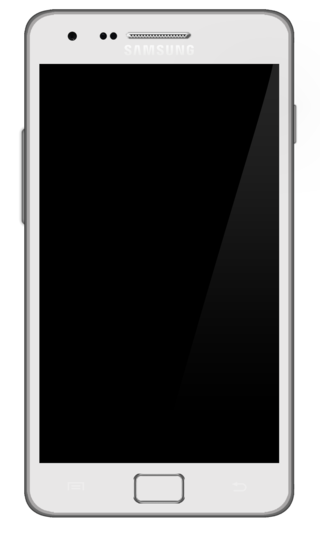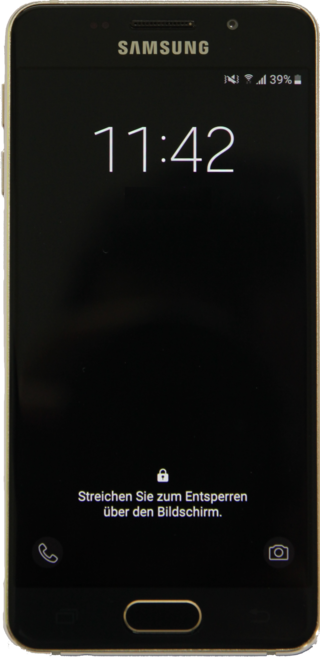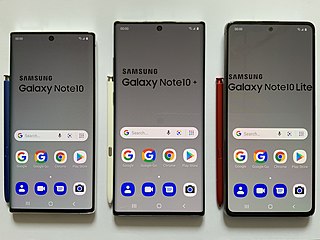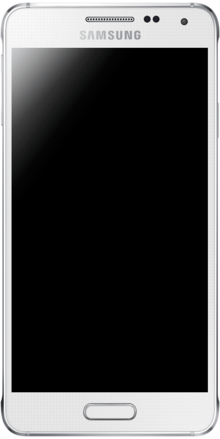
The Nexus S 4G is a smartphone co-developed by Google and Samsung and manufactured by Samsung Electronics for release in 2010. It was the first smartphone to use the Android 2.3 "Gingerbread" operating system, and the first Android device to support Near Field Communication (NFC) in both hardware and software.

The Samsung Galaxy S II is a touchscreen-enabled, slate-format Android smartphone designed, developed, and marketed by Samsung Electronics, as the second smartphone of the Samsung Galaxy S series. It has additional software features, expanded hardware, and a redesigned physique compared to its predecessor, the Samsung Galaxy S. The S II was launched with Android 2.3.4 "Gingerbread", with updates to Android 4.1.2 "Jelly Bean".
The Samsung Galaxy R (Royal) (GT-I9103) is an Android smartphone that was announced by Samsung on August 10, 2011 as a variant to the Samsung Galaxy S II.

The Samsung Galaxy S series is a line of flagship Android smartphone and tablet computer produced by Samsung Electronics. Together with the foldable Galaxy Fold and the now discontinued Galaxy Note series, the lineup serves as Samsung's flagship smartphone lineup.

The Samsung Galaxy Note series is a discontinued line of high-end Android phablets and smartphones developed and marketed by Samsung Electronics. The line is primarily oriented towards pen computing; all Galaxy Note models ship with a stylus pen and incorporate a pressure-sensitive Wacom digitizer. All Galaxy Note models also include software features that are oriented towards the stylus and the devices' large screens, such as note-taking, digital scrapbooking apps, tooltips, and split-screen multitasking. The line served as Samsung's flagship smartphone model, positioned above the Galaxy S series.

The Samsung Galaxy Note 4 is an Android smartphone developed and produced by Samsung Electronics. It was unveiled during a Samsung press conference at IFA Berlin on 3 September 2014 and was released globally in October 2014 as successor to the Samsung Galaxy Note 3. Improvements include expanded stylus-related functionality, an optically stabilized rear camera, significantly increased charging rate, revised multi-windowing, and fingerprint unlocking. It is the last in the Samsung Galaxy Note series with interchangeable battery. Its subsequent model, the Samsung Galaxy Note 5, was unveiled on 13 August 2015.

The Samsung Galaxy S5 is an Android-based smartphone unveiled, produced, released and marketed by Samsung Electronics as part of the Samsung Galaxy S series. Unveiled on 24 February 2014 at Mobile World Congress in Barcelona, Spain, it was released on 11 April 2014 in 150 countries as the immediate successor to the Galaxy S4. As with the S4, the S5 is an evolution of the prior year's model, placing a particular emphasis on an improved build with a textured rear cover and IP67 certification for dust and water resistance, a more refined user experience, new security features such as a fingerprint reader and private mode, expanded health-related features including a built-in heart rate monitor, a USB 3.0 port, and an updated camera featuring speedy auto-focus through phase-detection as well as video resolution upgraded to 2160p (4K) and framerate at 1080p doubled.

The Samsung Galaxy Note 3 Neo is an Android phablet smartphone produced by Samsung Electronics. The Galaxy Note 3 Neo was unveiled by Samsung Poland on February 1, 2014, with its worldwide release later in that month. Serving as a lower priced version of the Samsung Galaxy Note 3, the Note 3 Neo was designed to have the same lighter, more upscale design than previous iterations of the Galaxy series first supported by its bigger sibling, and to expand upon the stylus and multi-tasking oriented functionality in its software, which includes the new navigation wheel for pen-enabled apps, along with pop-up apps and expanded multi-window functionality, while lacking more sophisticated functionality such as 1080p video recording and USB 2.0 port.

The Samsung Galaxy A5 (2015) or Samsung Galaxy A5 2015 Edition is an Android smartphone produced by Samsung Electronics. Serving as a premium upper mid-range device, it was introduced on 30 October 2014, along with the smaller and related Samsung Galaxy A3 (2015) and larger Samsung Galaxy A7 (2015) introduced later in January 2015. The Samsung Galaxy A5 (2016) is a successor to the Samsung Galaxy A5 (2015) edition, featuring a revised metal and glass build that debuted with the Galaxy S6.

The Samsung Galaxy Note 5 is an Android-based phablet designed, developed, produced and marketed by Samsung Electronics. Unveiled on 13 August 2015, it is the successor to the Galaxy Note 4 and part of the Samsung Galaxy Note series.

Samsung Galaxy A3 (2016) or Samsung Galaxy A3 2016 Edition is an Android smartphone produced by Samsung Electronics. It was introduced on 2 December 2015, along with Galaxy A5 (2016), Galaxy A7 (2016), and Galaxy A9 (2016).

The Samsung Galaxy S7, Samsung Galaxy S7 Edge and Samsung Galaxy S7 Active are Android-based smartphones manufactured, released and marketed by Samsung Electronics. The S7 series serves as the successor to the Galaxy S6, S6 Edge, S6 Edge+ and S6 Active released in 2015. The S7 and S7 Edge were officially unveiled on 21 February 2016 during a Samsung press conference at Mobile World Congress, with a European and North American release on 11 March 2016. The S7 Active was unveiled on 4 June 2016, and released on AT&T in the United States on 10 June 2016.

The Samsung Galaxy A series is a line of mid-range smartphones and tablets manufactured by Samsung Electronics as part of their Galaxy line. The first model in the series was the first-generation Galaxy Alpha, released on 31 October 2014.

The Samsung Galaxy J7 (2016) is an Android-based mid-range smartphone produced by Samsung Electronics in 2016 and is either based on the Qualcomm Snapdragon 615 or Exynos 7870 chipset.

The Samsung Galaxy S9 and S9+ are Android-based smartphones unveiled, manufactured, released and marketed by Samsung Electronics as part of the Samsung Galaxy S series. The devices were revealed at the Mobile World Congress in Barcelona on 25 February 2018, as the successors to the Samsung Galaxy S8 and S8+.

The Samsung Galaxy Note 10 is a line of Android-based phablets designed, developed, produced, and marketed by Samsung Electronics as part of the Samsung Galaxy Note series. They were unveiled on 7 August 2019, as the successors to the Samsung Galaxy Note 9. Details about the phablets were widely leaked in the months leading up to the phablets' announcement.

The Samsung Galaxy S20 is a series of Android-based smartphones designed, developed, marketed, and manufactured by Samsung Electronics as part of its Galaxy S series. They collectively serve as the successor to the Galaxy S10 series. The first three smartphones were unveiled at Samsung's Galaxy Unpacked event on 11 February 2020 while the Fan Edition model was unveiled at Samsung's Galaxy Unpacked event on 23 September 2020.

Samsung Galaxy A21s is a mid-range Android smartphone designed, developed, marketed, and manufactured by Samsung Electronics as part of its Galaxy A series.
The Samsung Galaxy A12 is an Android smartphone manufactured by Samsung Electronics. The phone was announced in November 2020 as a successor to the Samsung Galaxy A11. The phone has a quad-camera setup with a 48 MP main camera and a 6.5 in (170 mm) HD+ Infinity-V display. The Li-Po battery has 5000 mAh, which is 62% bigger than the battery of the iPhone 13 Pro. It ships with Android 10 and now can be updated to Android 12.

The Samsung Galaxy Xcover 5 is an Android-based smartphone designed, marketed, and manufactured by Samsung Electronics. It was announced on March 4, 2021. The phone has a single-camera setup with a 16 MP main camera, a 5.3 in HD+ display, and a 3000 mAh Li-Ion battery. It ships with Android 11.



















